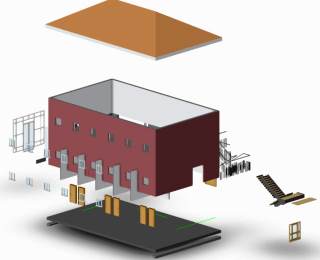06 June 2017
 UniSA researchers have secured one of only eight prestigious ARUP Global Research Grants to further a project that aims to deliver an innovative product-service system business model to provide changeable, adaptable parts of buildings via a ‘cloud data platform’ linking physical components to virtual models.
UniSA researchers have secured one of only eight prestigious ARUP Global Research Grants to further a project that aims to deliver an innovative product-service system business model to provide changeable, adaptable parts of buildings via a ‘cloud data platform’ linking physical components to virtual models.
The one-year research project is expected to revolutionise the building industry, not only creating new business opportunities in the service sector, but also deriving more value from built resources by their reuse, adaptation and life-cycle stewardship.
A research-driven international firm of designers, planners, engineers and technical specialists, ARUP stages its Global Research Challenge as part of its mission to “shape a better world” by developing and supporting great ideas that will stand the test of time.
This year’s two themes – including adaptation of circular economy principles on, or in built environment projects - attracted 120 applicants worldwide.
Led by Adjunct Associate Professor David Ness, the multi-disciplinary team comprises Dr Ke Xing, Dr Ki Kim, John Gelder, Adam Jenkins and Dr Xing Ma from UniSA, in association with Dr John Swift, head of Prismatic Architectural Research (and inventor of some core concepts).
Assoc Prof Ness says the concept for the project arose from the team’s previous research on smart, reusable components, product-service system solutions and resource efficiency.
“We have clear goals to reduce building waste, greenhouse gas emissions and create new business opportunities; this research aims to develop a cloud enhanced-system that will be able to be adopted widely across the building industry and focus on waste reduction and appropriate re-use of materials,” Assoc Prof Ness says.
ARUP Global Head of Research, Dr David Gerber says the UniSA proposal is exciting and full of potential.
“We are delighted to be supporting the research and keen to forge strong relationships, both locally in Adelaide and globally. We look forward to supporting the work through close collaboration and by providing ARUP technologies, connections and know-how,” Dr Gerber says.
ARUP is investing almost $78,000 in the project, which will be supplemented by a UniSA cash and in-kind contribution.
UniSA Pro Vice Chancellor; Division of IT, Engineering and the Environment, Professor Simon Beecham says the recognition from ARUP of the innovative nature of the research is remarkable.
“Winning support from one of the world’s most innovative and enduring engineering, design and planning organisations is no small feat,” Prof Beecham says.
“ARUP is a global player and one that has long been associated with some of the most challenging and innovative building projects around the world, including our own iconic Sydney Opera House.
“It is a great credit to the research team and to the calibre of their ideas that this exciting project has won support.”
Other partners include the Collaborating Centre for Sustainable Consumption and Production, Germany; building SMART Australasia; Emeritus Prof Stephen Kendall of Ball State University USA, co-leader of World Open Building Network, and Geneva-based Prof Walter Stahel, founder of the Circular Economy.
The team will be co-operating closely with ARUP, especially ARUP Project Manager and Adelaide Office Leader, John Haese and his colleague Nick Roach, Stuart Smith (ARUP Project Director, London) and Alex Sinickas, ARUP Head of Research Australasia.
Media contact: Michèle Nardelli mobile 0418 823 673 email michele.nardelli@unisa.edu.au
Contact for interviews: Associate Professor David Ness office 8302 1821 email david.ness@unisa.edu.au



